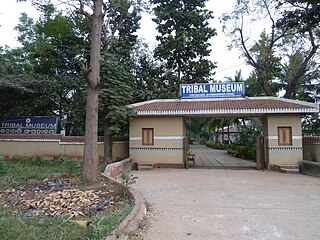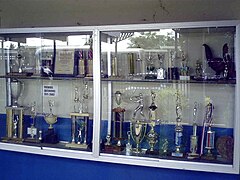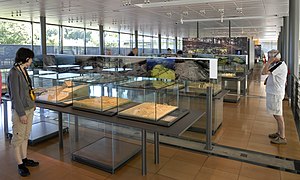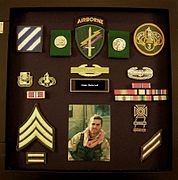
A desk or bureau is a piece of furniture with a flat table-style work surface used in a school, office, home or the like for academic, professional or domestic activities such as reading, writing, or using equipment such as a computer. Desks often have one or more drawers, compartments, or pigeonholes to store items such as office supplies and papers. Desks are usually made of wood or metal, although materials such as glass are sometimes seen.

The National Museum of American History: Kenneth E. Behring Center collects, preserves, and displays the heritage of the United States in the areas of social, political, cultural, scientific, and military history. Among the items on display is the original Star-Spangled Banner. The museum is part of the Smithsonian Institution and located on the National Mall at 14th Street and Constitution Avenue NW in Washington, D.C.

A trunk, also known as a travel trunk, is a large cuboid container designed to hold clothes and other personal belongings. They are most commonly used for extended periods away from home, such as for boarding school, or long trips abroad. Trunks are differentiated from chests by their more rugged construction due to their intended use as luggage, instead of the latter's pure storage.

A bookcase, or bookshelf, is a piece of furniture with horizontal shelves, often in a cabinet, used to store books or other printed materials. Bookcases are used in private homes, public and university libraries, offices, schools, and bookstores. Bookcases range from small, low models the height of a table to high models reaching up to ceiling height. Shelves may be fixed or adjustable to different positions in the case. In rooms entirely devoted to the storage of books, such as libraries, they may be permanently fixed to the walls and/or floor.

The Palazzo Vecchio is the town hall of Florence, Italy. It overlooks the Piazza della Signoria, which holds a copy of Michelangelo's David statue, and the gallery of statues in the adjacent Loggia dei Lanzi.

A replica is an exact copy or remake of an object, made out of the same raw materials, whether a molecule, a work of art, or a commercial product. The term is also used for copies that closely resemble the original, without claiming to be identical.

Glass floors are made with transparent glass when it is useful to view something from above or below; whereas translucent glass is used when there is no need to view through. In either case, toughened glass is usually chosen, for its durability and resistance to breakage.

A light fixture, light fitting, lamp, or luminaire is an electrical device containing an electrical component called a lamp that provides illumination. All light fixtures have a fixture body and one or more lamps. The lamps may be in sockets for easy replacement—or, in the case of some LED fixtures, hard-wired in place.

The Musée de l'Armée is a national military museum of France located at Les Invalides in the 7th arrondissement of Paris. It is served by Paris Métro stations Invalides, Varenne and La Tour-Maubourg
A pipe clamp is a type of clamp often employed in woodworking, piping or cabinet shops. When referring to woodwork or cabinet shops, pipe clamps are usually composed of commercially manufactured clamp heads or "jaws" and a length of common threaded pipe. The capacity of the clamp is determined by the length of the pipe used. When referring to piping, pipe clamps are used to connect the pipe to the pipe hanger assembly.
The MIT Museum, founded in 1971, is located at the Massachusetts Institute of Technology in Cambridge, Massachusetts. It hosts collections of holography, technology-related artworks, artificial intelligence, architecture, robotics, maritime history, and the history of MIT. Its holography collection of 1800 pieces is the largest in the world, though only a few selections from it are usually exhibited. As of 2023, works by the kinetic artist Arthur Ganson are the largest long-running displays. There is a regular program of temporary special exhibitions, often on the intersections of art and technology.

The National Museum of Indonesia is an archeological, historical, ethnological, and geographical museum located in Jalan Medan Merdeka Barat, Central Jakarta, right on the west side of Merdeka Square. Popularly known as the Elephant Museum after the elephant statue in its forecourt, its broad collections cover all of Indonesia's territory and almost all of its history. The museum has endeavoured to preserve Indonesia's heritage for two centuries.

The National Museum of Beirut is the principal museum of archaeology in Lebanon. The collection begun after World War I, and the museum was officially opened in 1942. The museum has collections totaling about 100,000 objects, most of which are antiquities and medieval finds from excavations undertaken by the Directorate General of Antiquities.

The Antalya Museum or Antalya Archeological Museum is one of Turkey's largest museums, located in Konyaaltı, Antalya. It includes 13 exhibition halls and an open air gallery. It covers an area of 7,000 m2 (75,000 sq ft) and 5000 works of art are exhibited. In addition a further 25,000–30,000 artifacts which cannot be displayed are in storage. As a museum exhibiting examples of works, which illuminate the history of the Mediterranean and Pamphylia regions in Anatolia, Antalya Museum is one of the most important of Turkey's museums. The Museum won the "European Council Special Prize" in 1988.

Mobile shelving, mobile aisle shelving, compactus,roller racking, or rolling stack, are terms applied to shelving or storage units fitted with wheeled traction systems. Units can be closely packed when access is not required, but can be readily moved to open up an aisle to allow access. By eliminating the need for a permanently open aisle between every unit, a smaller proportion of floor space can be allocated to storage than in the case of conventional fixed shelving, or a higher capacity of storage can be met using the same footprint as fixed shelving.

A shelf is a flat, horizontal plane used for items that are displayed or stored in a home, business, store, or elsewhere. It is raised off the floor and often anchored to a wall, supported on its shorter length sides by brackets, or otherwise anchored to cabinetry by brackets, dowels, screws, or nails. It can also be held up by columns or pillars. A shelf is also known as a counter, ledge, mantel, or rack. Tables designed to be placed against a wall, possibly mounted, are known as console tables, and are similar to individual shelves.

A cabinet is a case or cupboard with shelves and/or drawers for storing or displaying items. Some cabinets are stand alone while others are built in to a wall or are attached to it like a medicine cabinet. Cabinets are typically made of wood, coated steel, or synthetic materials. Commercial grade cabinets usually have a melamine-particleboard substrate and are covered in a high pressure decorative laminate, commonly referred to as Wilsonart or Formica.

Tribal Research Institute Museum, Museum of Tribal Arts and Artifacts, is a museum in Bhubaneswar, Odisha inside the campus of Scheduled Castes & Scheduled Tribes Research & Training Institute. It is popularly known as Tribal Museum and conceptually labeled as Museum of Man. It has life-sized authentic tribal dwellings, created by the tribal craftsmen offers a view of the State's tribal heritage. It has sections which showcase tribal artifacts and objects, focusing on well researched, documented cultural life of tribals of Odisha. It is headed by a Director, who is in the rank of a University Professor, and the administrative control lies in the hands of ST, SC, Minorities, and Backward Classes Welfare Department, Government of Odisha.

The conservation and restoration of wooden artifacts refers to the preservation of art and artifacts made of wood. Conservation and restoration in regards to cultural heritage is completed by a conservator-restorer.

The Metropolitan Museum of Art has on display a complete studio from the Palazzo ducale di Gubbio. Consisting of period woodwork from late 15th century Italy, the studio was commissioned for Federico da Montefeltro.































